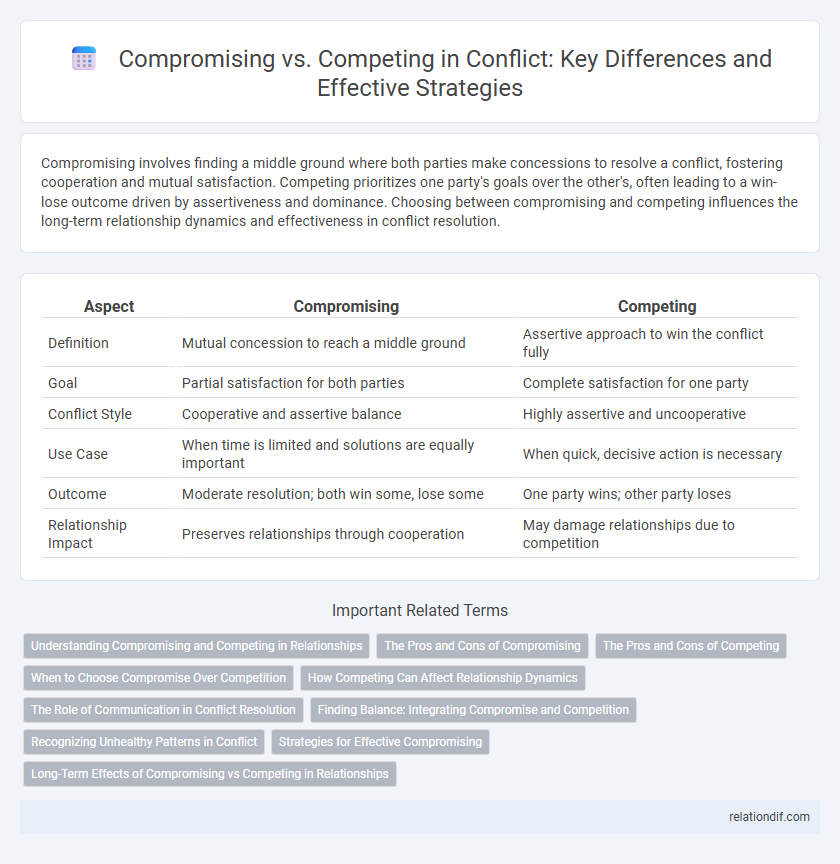Compromising involves finding a middle ground where both parties make concessions to resolve a conflict, fostering cooperation and mutual satisfaction. Competing prioritizes one party's goals over the other's, often leading to a win-lose outcome driven by assertiveness and dominance. Choosing between compromising and competing influences the long-term relationship dynamics and effectiveness in conflict resolution.
Table of Comparison
| Aspect | Compromising | Competing |
|---|---|---|
| Definition | Mutual concession to reach a middle ground | Assertive approach to win the conflict fully |
| Goal | Partial satisfaction for both parties | Complete satisfaction for one party |
| Conflict Style | Cooperative and assertive balance | Highly assertive and uncooperative |
| Use Case | When time is limited and solutions are equally important | When quick, decisive action is necessary |
| Outcome | Moderate resolution; both win some, lose some | One party wins; other party loses |
| Relationship Impact | Preserves relationships through cooperation | May damage relationships due to competition |
Understanding Compromising and Competing in Relationships
Compromising in relationships involves both parties making mutual concessions to reach a balanced solution that respects each other's needs, fostering collaboration and maintaining harmony. Competing emphasizes assertiveness and prioritizing one's own interests, which can lead to power struggles but may be necessary when quick, decisive action is required. Understanding when to employ compromising or competing strategies enhances conflict resolution by aligning approaches with the relationship's goals and emotional dynamics.
The Pros and Cons of Compromising
Compromising in conflict resolution allows both parties to find a middle ground, promoting cooperation and quicker agreements compared to competing strategies that often escalate tensions. However, compromising can result in suboptimal outcomes where neither party fully satisfies their interests, potentially leading to resentment or unresolved issues. This approach is effective in maintaining relationships but may not be suitable for conflicts requiring decisive or win-win solutions.
The Pros and Cons of Competing
Competing in conflict resolution offers the advantage of assertively defending one's interests, enabling quick decisions in high-stakes situations where cooperation is limited. However, it risks damaging relationships and fostering resentment due to its adversarial nature and potential neglect of others' needs. Effective use of competing requires careful consideration of context to balance achieving objectives with maintaining long-term collaboration.
When to Choose Compromise Over Competition
Choosing compromise over competition is essential when preserving relationships and fostering collaboration outweighs the need to win a conflict outright. Compromise is optimal in scenarios involving ongoing partnerships, team dynamics, or negotiations where mutual satisfaction enhances long-term success. Situations with shared goals or limited resources benefit from compromise, as it ensures equitable solutions while minimizing hostility and resistance.
How Competing Can Affect Relationship Dynamics
Competing in conflict often intensifies power struggles, leading to decreased trust and increased resentment between parties. This approach emphasizes winning over collaboration, which can damage communication and reduce the likelihood of long-term resolution. Persistent competition may cause relationships to become adversarial, weakening mutual respect and cooperation.
The Role of Communication in Conflict Resolution
Effective communication plays a crucial role in balancing compromising and competing strategies during conflict resolution, enabling parties to express needs clearly while understanding opposing viewpoints. Transparent dialogue fosters mutual respect and helps identify shared interests, reducing misunderstandings and promoting collaborative problem-solving. Skilled communicators can navigate power dynamics, ensuring that competing interests are addressed constructively without escalating tensions or hindering compromise.
Finding Balance: Integrating Compromise and Competition
Finding balance between compromising and competing requires blending assertiveness with cooperation to achieve mutually beneficial outcomes. By recognizing when to yield and when to stand firm, individuals can navigate conflicts effectively, ensuring both parties' interests are respected. Integrating these approaches fosters sustainable resolutions and strengthens relationships in challenging situations.
Recognizing Unhealthy Patterns in Conflict
Recognizing unhealthy patterns in conflict involves identifying when compromising leads to resentment due to unmet needs or when competing escalates tension by prioritizing winning over collaboration. Persistent compromising may create power imbalances, while constant competing can damage relationships and hinder productive resolution. Awareness of these patterns enables individuals to adopt healthier conflict strategies that support mutual respect and effective communication.
Strategies for Effective Compromising
Effective compromising strategies in conflict resolution involve identifying shared interests and ensuring that all parties make concessions that are reasonable and balanced. Clear communication and active listening help to establish mutual understanding, fostering trust and cooperation. Setting realistic expectations and prioritizing key issues enable negotiators to achieve solutions that satisfy essential needs without escalating the dispute.
Long-Term Effects of Compromising vs Competing in Relationships
Compromising in conflicts fosters long-term relationship stability by promoting mutual understanding and trust, reducing resentment over time. Competing may yield immediate wins but often damages relational bonds, increasing tension and decreasing cooperation in the long run. Research shows that prioritizing compromise leads to healthier, more resilient relationships compared to persistent competition.
Compromising vs Competing Infographic

 relationdif.com
relationdif.com